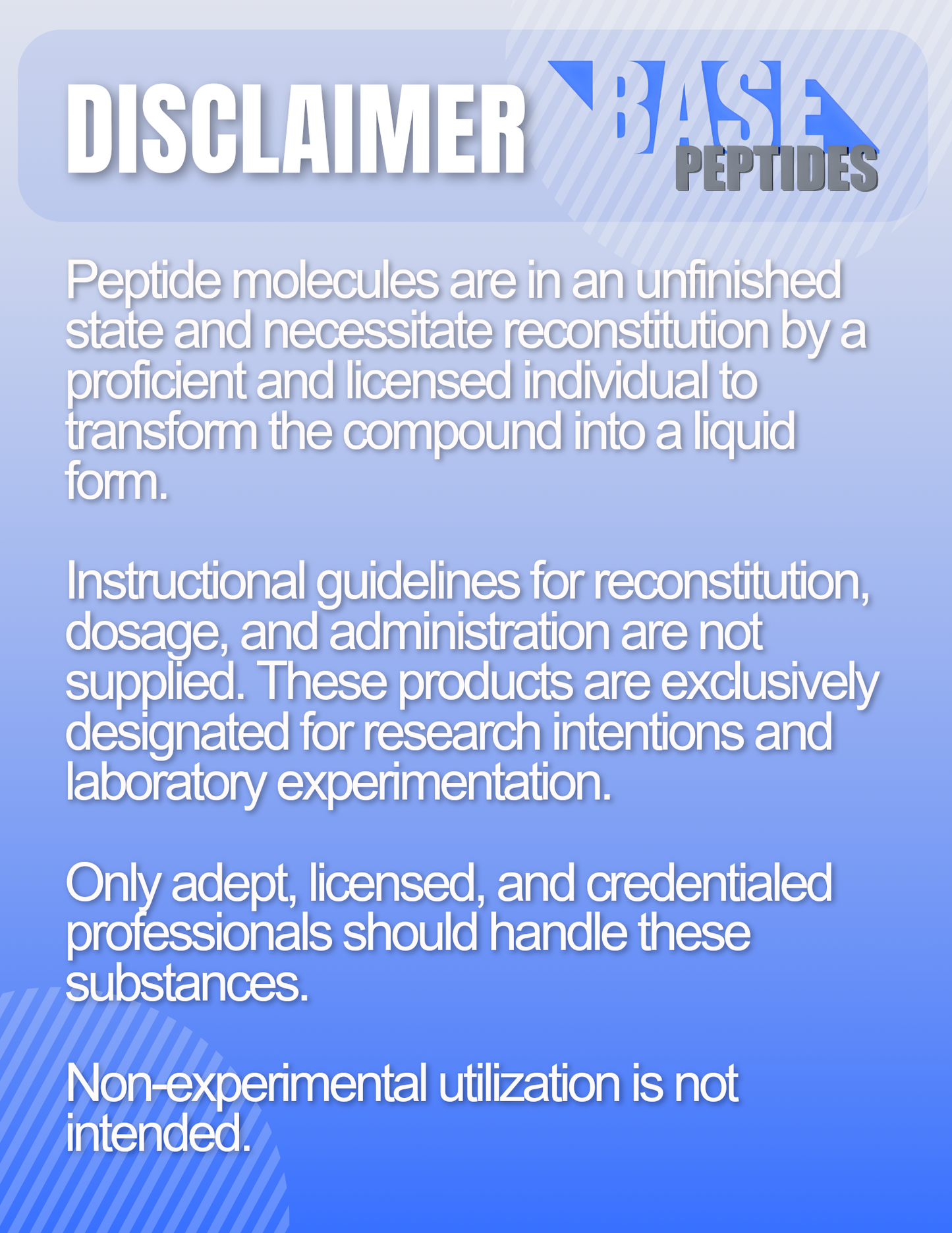Epithalon
Epithalon
Base Peptides are intended for licensed medical professionals and experienced researchers. Reconstitution required. Dosing and use instructions are not provided.
Couldn't load pickup availability
Epitalon (Epithalon) — Tetrapeptide Ala-Glu-Asp-Gly
Epitalon is a synthetic tetrapeptide (sequence Ala-Glu-Asp-Gly) originally derived from a natural pineal gland peptide extract. It is studied in cell, animal, and limited human research for its potential impacts on **telomerase activation**, **cellular ageing**, **sleep/pineal regulation**, and **oxidative-stress reduction**.
- Synonyms: Epithalon, Epithalone
- Sequence: Ala-Glu-Asp-Gly
- CAS No.: 307297-39-8
- Formula / MW (approx.): C₁₄H₂₂N₄O₉ · ~390.35 g·mol⁻¹
- Stimulates the enzyme telomerase, which helps maintain the ends of chromosomes (telomeres).
- Modulates the pineal gland and may increase melatonin production, thereby supporting circadian rhythm and sleep.
- Acts as an antioxidant / reduces reactive-oxygen species (ROS) and supports mitochondrial and gene-expression repair pathways. [oai_
- To examine mechanisms of ageing and cellular senescence (telomere shortening, mitochondrial decline).
- To study sleep/pineal-gland biology and melatonin regulation in older models.
- To test oxidative-stress, gene-expression, neurogenesis and stem-cell repair paradigms.
Key Studies — What Was Tested, What Changed, Why It Matters
Telomerase activation & longevity in vitro/in vivo
- What was tested: Cell-culture and animal models treated with Epitalon, measuring telomerase levels, telomere length, lifespan/aging markers.
- What changed: Up-regulation of telomerase activity, slower telomere shortening, extended lifespan in some rodent studies.
- Why it matters: Suggests a direct mechanistic link to ageing-biology via chromosome end-cap maintenance.
Pineal-gland / melatonin / endocrine regulation
- What was tested: Older animals/humans given Epitalon or pineal extract; melatonin levels, sleep metrics, circadian markers measured. [oai_citation:13‡Innerbody](https://www.innerbody.com/epitalon?utm_source=chatgpt.com)
- What changed: Enhanced melatonin secretion, improved sleep-related hormone profiles in older models.
- Why it matters: Indicates repair of age-associated endocrine decline via pineal axis.
Cellular repair & oxidative stress reduction
- What was tested: In vitro oocyte aging and stem-cell differentiation models treated with Epitalon; endpoints: ROS, mitochondrial membrane potential, gene expression.
- What changed: Reduced ROS, improved mitochondrial metrics, increased neuronal-marker gene expression.
- Why it matters: Shows broader capacity for repair/regeneration beyond telomerase.
Potential Research Applications
Longevity & Cellular Senescence
- Telomere length/maintenance assays; lifespan models in rodents.
- Senescent-cell clearance, mitochondrial function, stem-cell exhaustion endpoints.
Endocrine & Sleep Biology
- Pineal gland/melatonin regulation; circadian rhythm & hormone secretions.
- Age-related endocrine decline models (older animals/humans) including gonadotropins.
Cellular Repair / Mitochondria / Oxidative Stress
- ROS, mitochondrial membrane potential (Δψm), gene-expression (nestin, GAP43) in stem-cell/neurogenesis models.
Synergistic Peptides (for Study Design)
GHK-Cu
- Why pair: ECM/trophic gene programs—combines cellular-repair/telomerase (Epitalon) with matrix support (GHK-Cu).
- Angle: Use telomere/mitochondria endpoints + matrix gene arrays for layered repair read-out.
TB-500
- Why pair: Cytoskeletal/motility repair; alongside Epitalon’s cell-repair/mitochondria axis to explore connective-tissue regeneration.
Selank / Semax
- Why pair: Neuro-trophic/neuro-immune peptides—good for ageing/neuro-regeneration models when combined with Epitalon.
Design Notes
- Document cell-passage, baseline telomere length, mitochondrial baseline metrics when using in vitro/neurogenesis studies.
Known Concerns (Context)
- Evidence base limited: Many positive studies are from one research group in Russia; independent large-scale human trials are scarce.
- Telomerase activation caution: Telomerase is also active in some cancer cells—model design must monitor proliferative endpoints and tumour markers if appropriate.
- Research-use only: Not approved for therapeutic use in many jurisdictions; buyer must ensure proper labeling.
Specifications & Handling
- Form: Lyophilized peptide powder (lot-coded) – verify salt/acidity form.
- Purity: ≥ 99% (HPLC/MS verified) in research-grade preparations.
- Storage: ≤ −20 °C; protect from moisture and light; avoid repeated freeze-thaw cycles.
- In solution: Reconstitute in sterile buffer; document solvent/vehicle, pH; consider low-bind surfaces.
- Packaging: Tamper-evident; research-only labeling; ensure appropriate storage and disposal compliance.
Regulatory & Use Notice
Sold for laboratory research use only. Not for human consumption, medical, or veterinary use. No human-use instructions are provided. Buyer is responsible for safe handling and regulatory compliance.
Epitalon Peptide Research | Tetrapeptide Ala-Glu-Asp-Gly | Telomerase Activation, Cellular Repair & Longevity Studies






